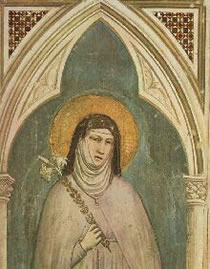
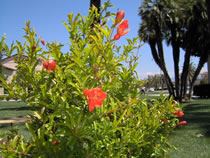
Pomegranate Shrub
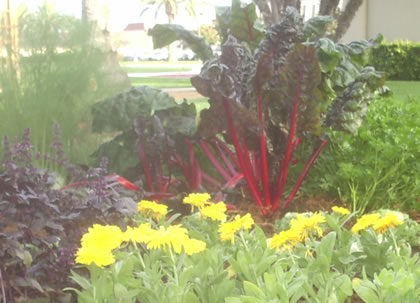
Clockwise from Left: Fennel, Swiss Chard, Parsley, Calendula, and Purple Basil
In the fall of 2001, Tom Turley, a medieval historian at Santa Clara University, inspired by the medieval garden project at Penn State University which features plants grown in Northern Europe, suggested that Santa Clara develop a medieval garden of its own. An ad hoc committee was formed in 2002 that included Dorothea French, Tom Turley, Russ Skowronek, Ann Beyer, Nancy Lucid, and Chris Young. Since Santa Clara has a Mediterranean climate, the group decided it should have a garden typical of Southern Europe. President Paul Locatelli generously set aside an area of lawn and trees near De Saisset Museum for the project, asking only that it be linked to Saint Clare of Assisi, the namesake of the university. The Nicholson Family donated funds in memory of Ruth Nicholson for the construction of the garden in 2003.
The Saint Clare Garden is not intended to be a slavish reconstruction of a particular garden. Little is know specifically about the original gardens at the church and convent of San Damiano where Clare lived a cloistered life. Instead, the garden includes many common features of medieval gardens based on the writings of the medieval scientist Albert the Great and the research of garden historians John Harvey, Sylvia Landsberg, David Coffin, Claudia Lazzaro, Georgina Masson, and horticulturist Peter Dallman (see More Information). With few exceptions, the plants in the St. Clare Garden are the ones typically found in thirteenth-century Italian Gardens---no zonal geraniums, dahlias, or petunias, popular flowers native to the New World, are in this garden! The plants include the humble pottage plants that Clare and her sisters relied upon for food (leeks, kale, etc.) mixed in with the most beloved symbolic flowering plants of the middle ages: roses, lilies, rue, sage, basil, violet, columbine, iris.
The garden also includes plants from the Italian countryside such as yarrow, sweet alyssum, catmint, and cranesbill geranium that Clare would have known and loved from her childhood. The garden features elements typical of the medieval herber or herbarium (a place of refreshment where decorative and useful plants were grown): a tunnel arbor, a garden enclosed with shrubs (or a fence or wall), geometrically laid out beds, a lawn, fruit trees, a water feature (dry or wet), a gravel walk way, and edible and decorative plants mixed together. The garden is divided into areas arranged to portray the life of St. Clare.
- Childhood: Wild plants Native to Central Italy (PDF)
- Girlhood: Medicinal and Household herbs commonly used during Clare's time (PDF)
- Conversion: Lavender Garden, a symbol of purification, surrounding a basin, a symbol of baptism and conversion (PDF)
- Monastic Life: Kitchen Garden with typical medieval vegetables (PDF)
- Spiritual Life: Mary Garden, flowering plants traditionally associated with the Virgin Mary and Jesus (PDF)
Layout of Quadrants of Garden (PDF)
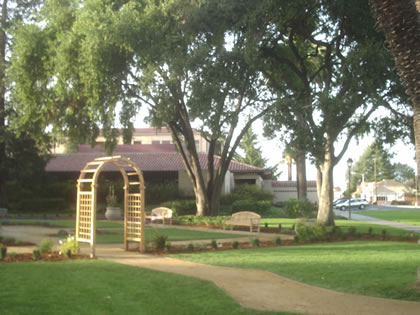
California Bay Tree, center, Live Oak, right
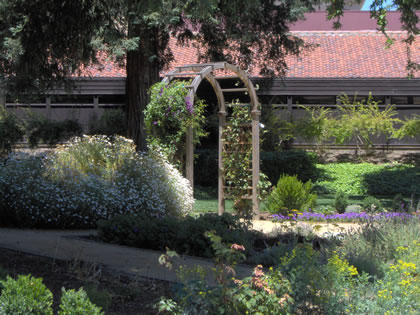
St Claire Arbor
The garden is located near the main front drive of the university between De Saisset Museum and Daly Science Building. It is nestled between mature specimens of native California trees: a California Bay (Umbellularia californica), California Live Oaks (Quercus agrifolia),and a Coast Redwood (Sequoia sempervirens).
These venerable trees serve as an attractive background to the garden, making it seem older than it is. The presence of a California Bay Tree and Live Oaks is especially felicitous because they are so similar to two trees common in the forests around Assisi, Bay Laurel (Laurus nobilis) and Holm Oak (Quercus ilex). Early Spanish settlers called the Live Oak “encino,” their name for the Holm Oak of Southern Europe. And they used the leaves of California Bay Trees in cooking just as they had used the leaves of the Bay Laurel in Spain.
This web site was written and designed by Nancy Lucid whose research was supported by a generous grant from the Bannan Institute for Jesuit Educational Mission at Santa Clara University.
For questions regarding the web site contact Nancy Lucid. All rights reserved.